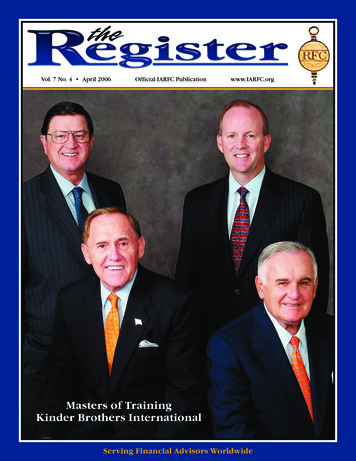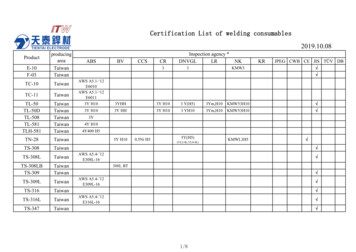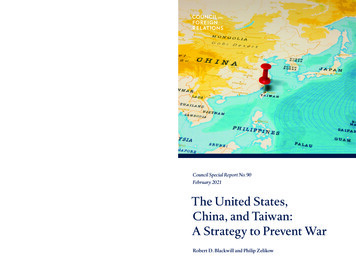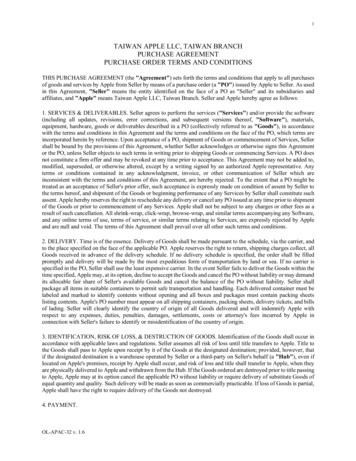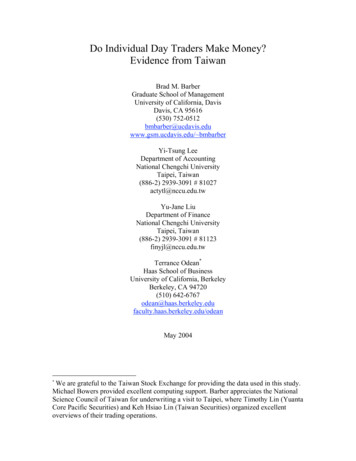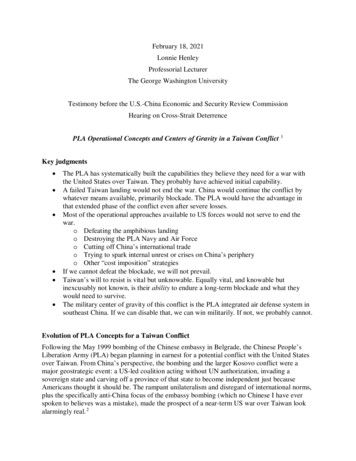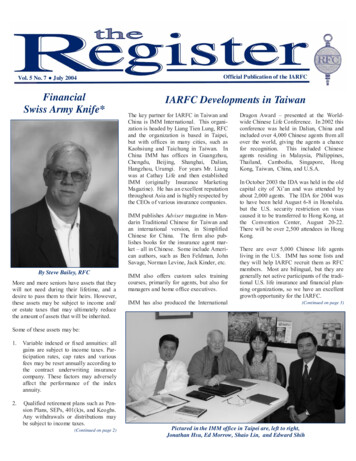
Transcription
Vol. 5 No. 7 July 2004FinancialSwiss Army Knife*Official Publication of the IARFCIARFC Developments in TaiwanThe key partner for IARFC in Taiwan andChina is IMM International. This organization is headed by Liang Tien Lung, RFCand the organization is based in Taipei,but with offices in many cities, such asKaohsiung and Taichung in Taiwan. InChina IMM has offices in Guangzhou,Chengdu, Beijing, Shanghai, Dalian,Hangzhou, Urumgi. For years Mr. Liangwas at Cathay Life and then establishedIMM (originally Insurance MarketingMagazine). He has an excellent reputationthroughout Asia and is highly respected bythe CEOs of various insurance companies.IMM publishes Adviser magazine in Mandarin Traditional Chinese for Taiwan andan international version, in SimplifiedChinese for China. The firm also publishes books for the insurance agent market – all in Chinese. Some include American authors, such as Ben Feldman, JohnSavage, Norman Levine, Jack Kinder, etc.By Steve Bailey, RFCMore and more seniors have assets that theywill not need during their lifetime, and adesire to pass them to their heirs. However,these assets may be subject to income and/or estate taxes that may ultimately reducethe amount of assets that will be inherited.IMM also offers custom sales trainingcourses, primarily for agents, but also formanagers and home office executives.IMM has also produced the InternationalDragon Award – presented at the Worldwide Chinese Life Conference. In 2002 thisconference was held in Dalian, China andincluded over 4,000 Chinese agents from allover the world, giving the agents a chancefor recognition. This included Chineseagents residing in Malaysia, Philippines,Thailand, Cambodia, Singapore, HongKong, Taiwan, China, and U.S.A.In October 2003 the IDA was held in the oldcapital city of Xi’an and was attended byabout 2,000 agents. The IDA for 2004 wasto have been held August 6-8 in Honolulu.but the U.S. security restriction on visascaused it to be transferred to Hong Kong, atthe Convention Center, August 20-22.There will be over 2,500 attendees in HongKong.There are over 5,000 Chinese life agentsliving in the U.S. IMM has some lists andthey will help IARFC recruit them as RFCmembers. Most are bilingual, but they aregenerally not active participants of the traditional U.S. life insurance and financial planning organizations, so we have an excellentgrowth opportunity for the IARFC.(Continued on page 3)Some of these assets may be:1.Variable indexed or fixed annuities: allgains are subject to income taxes. Participation rates, cap rates and variousfees may be reset annually according tothe contract underwriting insurancecompany. These factors may adverselyaffect the performance of the indexannuity.2.Qualified retirement plans such as Pension Plans, SEPs, 401(k)s, and Keoghs.Any withdrawals or distributions maybe subject to income taxes.(Continued on page 2)Pictured in the IMM office in Taipei are, left to right,Jonathan Hsu, Ed Morrow, Shaio Lin, and Edward ShihThe Register July 2004 Page
(Continued from page 1)3.Financial Planning Building2507 North Verity ParkwayMiddletown, OH 45042-0506800 532 9060 Fax 513 424 5752w w w . I AR F C . or gBOARD OF DIRECTORSEdwin P. Morrow, Chairman & CEOCLU, ChFC, CFP, CEP, RFCedm@IARFC.orgJudith Fisette-Losz, Executive Directordirector@IARFC.orgWendy M. Kennedy, Editorwendy@IARFC.orgH. Stephen Bailey, PresidentLUTCF, CEBA, CEP, CSA, RFCsteve@hbfinancial.comL. Ann CoulsonMS, Ph.D., CFP, RFCcoulson@humec.ksu.eduJohn E. GrableMBA, Ph.D, CFP, RFCgrable@humec.ksu.eduVernon D. GwynneCFP, RFCfsxfirst@aol.comRichard D. LandsbergJD, LLM, APM, RFCLandsbr@nationwide.comEdward J. LedfordCLU, RFCeledford@marketsharefinancial.comConstance O. LuttrellRFCluttrell@mindspring.comRuth LyttonMS, Ph.D., RFCrlytton@vt.ecuJames McCarty, SecretaryCLU, RHU, LUTCF, RFCjimmccarty@showbizsilling.comBurnett Marus, TreasurerRFCbmarus@sbcglobal.netWilliam J. NelsonLUTCF, CEP, RFCbilln@nelsonfinancial.comRonald K. StairAEP, EA, MLT, Ph.D., RFCrstair@cpd-nfg.comTraditional IRAs: Withdrawals ares ubj e c t t o i nc o meta xe s .4. Taxable estates in excess of 1.5 million increasing upward will be payingnearly half of the assets in estatetaxes. In 2011, this tax law might beput back into full force.Financial issues will also be a concern ifyour clients fall into one or more of thefollowing categories:1.Folks who want to buy Long TermCare (LTC) insurance, but don’t wantto lose the funds if they are not usedfor nursing home care.2. Asset owners who have had significantgrowth over a long period of time.3.Annuity and qualified plan owners.4.Annuity owners who have old annuities that have built up substantialgains.Financial products can be inefficient whenheirs owe income taxes on the values atthe owner's death. But there is a solutionthat can be used in almost all of the abovecases and can even protect a senior fromnursing home costs. It’s such a versatileproduct, I like to call it a financial SwissArmy Knife, because it serves so manyfunctions. It may be hard to believe thatthe product I am referring to is a singlepremium life insurance policy (SPL) withan LTC rider that pays a portion of thedeath benefit for home health or nursinghome care.Here’s how it works. You roll over anasset either by 1035 exchange (nonqualified) or by a rollover (qualified) intoan SPL/LTC. (It’s important to rememberthat at age 70 1/2, you must take out theRequired Minimum Distribution (RMD)on a yearly basis if you have a contractthat is qualified.) If your clients are presently having the RMD taken out of another qualified plan, you may have it deposited into the SPL/LTC policy. It will benon-qualified, since your clients have already paid taxes on those funds when theyreceived them at distribution.Let’s try and understand this SPL/LTCpolicy. If you deposit 100,000 in a lumpsum, it creates a total cash surrender valueof 100,000 and a total death benefit/LTCbenefit balance of 185,619.If your client goes to a nursing home, theannual cost may be 36,000 per year. Thisamount would be subtracted from the 185,619 benefit balance, which leaves abalance of 149,619. This is the amount thatyour client’s beneficiary would receive ifdeath occurred after the first year. The beneficiary may receive these funds income taxfree under section 101A of the InternalRevenue Code. And if your clients needadditional funds for an emergency, you canget them out of the cash value of the lifeinsurance policy through a cash value loan.This would create a loan against the deathbenefit, which would reduce the death benefit by the loan value.Let’s review some high points: If your clientneeds home health care or nursing homecare, or if they need money for an emergency, you may take it out of the cash value.What is left will be paid to your beneficiaries.We hear a lot of seniors asking what theycan do with the RMD that they must takeout of their qualified accounts. If they don'tneed it as income, they can deposit it yearlyinto this type of policy and it will createthese same types of benefits.Make sure that you give purchasers thecomparisons located in the “Shopper'sGuide to Long Term Care Insurance” provided by your State Insurance Dept. Also,do your homework to see how your clientwants to handle the funds. They can beguaranteed by the insurance company, orinvested in a Variable Life Insurance Policythat has sub-accounts, just like mutualfunds.If you come up with some other ideas forthis type of policy or my Swiss Army Knife,please let me know.* I stole the use of this term from Ben G.Baldwin, RFC, who is a true expert in theuses of the Variable Life policies. I am indebted to Ben Baldwin for this original basic idea. About the Author: IARFC President, H.Stephen Bailey is a Registered Representative offering securities through FFP Securities, Inc. Member NASD/SIPC. RegisteredInvestment Advisor through FFP AdvisorServices, Inc. He is president of HB Financial Resources, Ltd. You can reach Steve at:800 849 4656 or steve@hbfinancial.com.The Register July 2004 Page 2
(Continued from page 1)The key playersat IMM, eachof whom areRFC, are: Liang Tien Lung,Chair ma n,Jonathan Hsu,Chief of Staff,RichardWu,Vice Presidentof Taiwan Operations, ChooSiakLeung,PresidentofChina Operati ons ,Ja c kYeow, President of S.E.Seated left to right: Chang Miaoti, head of the Business School atAsia,HuangBeijing Union University, Li Peijun, the president of the University,Wu Qi, President Ed and Charlene Morrow. Standing left to right, Cynthia Ku (Beijingof IARFC China office employee) Ku Tseliang, Party Secretary of the Business SchoolD e v e l o p me n t , at Beijing Union University, Kai Tu, RFC Met Life VP in Beijing,and Jeffrey Chen, Wu Qi Huang, RFC, Edward Shih, RFC and Jonathan Hsu, RFCCEO of Taiwanpromotion and Developments Center.Taipei holds classes at Taiwan University,but taught by IMM staff and instructors.IMM has been developing excellent supportThey also have classes underway at thetools for the financial advisor – they publishlocal ING offices and now at the Taishina Register newsletter, 16 pages, distributedInsurance Agency – a large bank assurwithin Taiwan in traditional Mandarin andance operation operating from Taishinnow a separate version in simplified ChiBank Offices. In each of these distributivenese for distribution within China. Theyoperations we are holding class for abouthave developed a 7” x 9” leatherette bound40 students and should graduate a steadyand gold imprinted Continuing Educationflow of 35-40 RFCs per year from eachHandbook for each new RFC. Each alsosource.receives a small supply of stationery, letterhead, envelopes and business cards. IMMEdward Shih was the IMM staff person inprints Certificates from the IARFC formatcharge of RFC operations, but he has reand has an excellent website, IARFCtired and that position is now filled byTaiwan.org and is building a comparableJeffrey Chen, RFC and experienced finanone for China. It has classes underway nowcial lecturer and educator. Initial commuin the three largest cities of Taiwan: Taipeinications were handled through Jonathan5 million, Kaohsiung 3 million, andHsu, RFC, who lived in the U.S. andTaichung 1 million.graduated from USC. Jonathan has extensive experience in the MICE (Meetings,Kaohsiung is at the southwestern tip of TaiIncentive, Conference, Exhibit) industrywan. It is a heavy industrial and shippingand will be helping us with conferencescity. Meetings are held in a nice auditoriumand trips. Communications are now beingat a business school and we just presentedrouted through Rosemary who can beRFC certificates to the second class of stureached at: rosemary@imm.com.tw.dents. Enrollment is continuing and thelocal IMM office is an effective promoter.Through its magazine publications in bothTaiwan and China, IMM is advancing theTaichung is normally reached by motorsophistication of the life insurance induscoach and it is about 70 miles north oftry and also positioning the RFC as theKaohsiung, midway between Taipei in thedesignation in the financial services indusnorth and Kaohsiung in the south. It is atry. Each issue of the publications includemanufacturing and light industry center andarticles from the U.S IARFC publicationsmeetings are held in a nice auditorium in a– all very well presented with professionalnice hotel ballroom.graphics and layout. INTERNATIONALIARFCCOORDINATORSJeffrey ChiewAsia Regional ChairDBA, CLU, ChFC, CFP, RFCcchwee@pc.jaring.myLiang Tien LungAsia Development Organization (IMM)RFCRalph LiewPhilippines ChairRFCkilhk@myjaring.netJerry TanSingapore ChairCIAM, CMFA, RFCjerry@iarfcsg.orgHuang Wu QiChina Chair, GuangzhouRFC, AMTCIarfc-china@tom.comBilly B. Ray TamHong Kong and Macao ChairLL.B., LL.M., RFCbilly@hoeandtam.hk.netNg Jyi WeiMalaysia ChairChFC, CFP, RFC(M), RFCiarfcmgt@time.net.myAidil Akbar MadjidIndonesia ChairMBA, RFCakbar@pb-co.comJeffrey ChenTaiwan ChairRFCrosemary@imm.com.twThe Register July 2004 Page 3
Mid Year PlanningWhy this is so important: Communication with your contacts iscritical – whether cementing relationshipswith your best clients or building trust andconfidence with prospects. To achieve the level of communicationdesired you must employ a variety ofmaterials. Newsletters, birthday cards,letters, reprints and articles like this one. You could research, write and fact checkan article like this yourself - but wouldn’tyour time be more effectively spent faceto face with your contacts? When your clients, and even your prospects, have questions about the changes intheir own particular situation who willthey call? The article is 4 pages and briefly illuminates all of the following areas that are ofconcern to individuals, families, and business owners:2004 Tax RatesCapital Gains ChangesRetirement PlansHealth Savings AccountsBusiness DepreciationCollege SavingsWhat you get: We will send by return e-mail two Microsoft Word documents: the 2004 Mid YearTax Planning Memo, and a cover letteryou may use to accompany the memo. You may review, edit and personalizethese documents, then print them for delivery to your most important contacts. Take advantage of this offer quickly to beperceived as timely and sharp.From the Chairman’s desk What’s Your Password?We are talking, of course, about the password you must enter to edit your new FinancialAdvisor Profile at our website: www.IARFC.org, Click on Search for an RFC.Access your personal record and review the current copy. Go to the bottom to accessthe Edit Routine. Enter your last name all in lower case letters as it currently appearson the website. This enables you to enter Edits. Press the Edit Profile button.Make all the changes and additions you consider appropriate. When you reach the bottom of the edit routine, be sure to click on “Send These Changes” in order for youredits to be posted.We strongly suggest that at the outset, do not change this password. The reason is thatwe do not have an automatic password look up feature. If you change the password,and lose it, you’ll have to e-mail us (director@IARFC.org) and wait a full business dayfor a reply.Whenever you edit your web profile a copy is sent to us to update our records. If someone attempts to enter obviously fraudulent information we will catch this upon review.Many advisors report that they use the same password for lots of accounts. This maynot have maximum security, although it is much easier to remember.Edit Your Profile Today. Certainly you want to be sure we are listing your currentaddress, phone, e-mail and website.Add Other Designations. We encourage you to check off all designations you mayhave and insert any that aren’t on the list. Please do not use commas.Check Services and Products Offered. This tells your prospects, clients, other advisors and media what you offer and regularly provide. We placed the Services first inorder to emphasize the value of your advice and consultation.Comprehensive Plans. Do you offer them on a free basis? If so, you might say something like, “Comprehensive Plans, having a 1,500- 2,000 value, are generally produced for our new clients at no cost.Specialization and Services. This is your opportunity to expand on your background,education, services and unique offerings. It is a great selling opportunity. You want tobe respectful and not too aggressive, but the goal is to help distinguish yourself from allother advisors. You may also enter any broker/dealer required language at the very end.Save Your Changes. When you have worked hard on your text – save it, review andthen edit again and again if necessary.Upload Your Photo. Get a good, high quality “head shot” photo. Trim off unnecessary portions using a “cropping tool” and upload it in a GIF or JPG format.What to Tell Prospects.Only 95Call Now 800 666 1656www.FinancialSoftware.com“Every financial journalist, writer, talk show host or TV commentator agrees: Don’t dobusiness with someone unless you have checked out their credentials! You need to dothis before giving someone your private information and certainly before entrustingyour money to anyone. Go to: www.IARFC.org the International Association of Registered Financial Consultants. Enter the name of any prior advisor or agent and see ifthey are listed. Enter my name and verify for yourself that I’m listed.”If you are with the prospect, of course, you could help them perform this check, but it ismore powerful when the client does this personally. That’s why we list the IARFCwebsite on the back of all the consumer brochures. The Register July 2004 Page 4
How to work in an outrageouslyproductive working environment!financial planner is organizing and accomplishing the financial goals of their clients.Many financial planning professionals getso wrapped up in helping others that theyforget about their personal and professional needs. We help financial planningprofessionals find their core talents, attractand retain new talent and coach themthrough a business process that keepsthem accountable and productive withoutsacrificing personal time.Register: Why do you think coaching isimportant?Angie Herbers, RFCOver the years, we have supported the notion of coaching for financial advisors.There is a new company offering coachingand consulting services to help financialadvisors build outrageously productiveworking environments. We recently had theopportunity to interview company founder,Angie Herbers, and what we learned fromher youthful, passionate personality mighthelp you discover your true potential andnew innovative ways of doing business.Register: Tell us a little bit about yourcompany, Financial Advisor Resource, Inc.Angie: Five years ago, I entered the financial planning profession. After networkingat many industry conferences and workingwith two high-profile planners, I discoveredan on-going need for personalized coachingand consulting services for financial advisors. Many planners today are seeking tofind a work-life balance between their financial planning business and their personalneeds. The market for financial advisorshas never been greater. With this spur indemand comes a need for new, innovativeservices to keep advisors ahead of theircompetition. We created Financial AdvisorResource Inc. to help fill this need.Register: What prompted you to create thiscompany?Angie: Mostly my personal experienceworking with over 200 financial advisors.In my opinion, the primary function of aAngie: Think about financial planningclients. You coach and provide them solutions to their financial situation that couldmean the difference between a fundedretirement or something less. You striveto make them better. We do the samething, with the same principles. We wantthe careers of financial planners to be justas rewarding as retirement is to their clients. In this increasingly complex professional world, one simply cannot accomplish everything alone. Our service is anoutlet to help financial planners find timeto think about their business, their clientsand how they will thrive, instead of justsurvive in financial planning.Register: What is the major benefit ofcoaching to financial advisors?Angie: Accountability. It is to easy tooverlook, or put on hold, strategic business planning whether that is converting tofees, managing a client base, marketing orhiring support staff. We can help plannersstay accountable for their business planning objectives. This is an area that cannot be overlooked. There are thousands ofnew financial planners entering the markettoday. A recent study (the Jobs Almanac)listed financial planning as one of the hottest careers to pursue. Financial plannerswill need to make sure that their businesscan compete and thrive in the market.Register: Tell us more about how youhelp advisors manage time?Angie: Time management is strategic. Itis not just about scheduling meetings andhitting deadlines. It’s about outlining whatis important and blocking out time to do it.A good example of this is how we conductbusiness. We have a five year plan for ourbusiness complete with goals to accomplish.It is sometimes hard to put aside administrative tasks to meet these targets. I sometimes catch myself procrastinating bychecking email over and over again. However, our livelihood depends on how wellwe meet these objectives. In order to accomplish them, we have to strategicallyblock out time in the workweek to disconnect and focus. Planners have to do thesame. To be successful, they should alsoschedule time to plan for success.Register: Why are you so passionate aboutworking with financial advisors?Angie: I truly believe the financial planning industry needs this service more thanany other profession. Before starting thiscompany, I owned two other successfulbusinesses. Each industry that I worked inhad a standard system of carrying out business that each consumer came to expect.What determined business success, in thoseindustries, was how efficiently a business,internally, carried out the service and how itcommunicated that value.In the financial planning industry, it is different. A standard business model does notexist and I do not believe that consumersknow what to expect. Because of this, somefinancial planning professionals are haphazard in the way they conduct business andhave to spend time educating the client.This creates confusion and frustration andcan lead to unproductive working environments not to mention loss of profits. A wayto solve this problem is by creating a detailed process or an “organizational map”that outlines the expectations of both theconsumer and the advisor.Register: What advise would you give afinancial planning professional looking for acoach?Angie: What would you say to a consumerseeking financial planning advice? Mostpeople would say “someone you can trust.”(Continued on page 6)The Register July 2004 Page 5
(Continued from page 5)You have to trust your coach and know thatthey are looking out for your best interests.A successful coaching relationship will seekto help you find a process in your businessthat is productive and realistic based onyour time, values and business interests.Also, I would recommend that financialplanners find a coach that understands thefinancial planning industry or has experience working in it. The financial planningindustry is unique and if you do not have acoach that understands the complex natureof the industry, you will spend the majorityof your time and money educating them to apoint that they can actually help you.Register: Besides coaching do you offerany additional services?Angie: Throughout the past year, we havebeen working on processes that help financial planning professionals attract and retainnew talent. We have seen first hand thebenefits of hiring para planners or interns.We are now offering services to help advisors attract, find and retain talent. It is notenough to just hire someone anymore. Youhave to develop a strategic plan to unlockpotential and retain these new planners longterm. If you go into the hiring process without a plan, you will end up training yourcompetition in the future.Register: Process and procedures seem tobe important concepts, can you tell us more?Angie: Clearly defined processes and procedures make managing time and talenteasy. If you have a documented process fordoing business you are able to see whereyou are and more importantly, where youneed to go in the future to accomplish agoal. Forecasting future needs and forwardthinking is a strategic process that we striveto help more financial planners develop.Register: Time Management seems to be afoundation for your firm. What typical –problems do you see in practices across thecountry?Angie: Honestly, the major problem I seein financial planners is their ability to manage their staff. I have seen extremely successful financial planning processes failbecause the staff cannot understand or carryout the process. If the staff does not buyinto the process, then the productivity of thefinancial planner can not be improved. Iffinancial planners do not embrace thischallenge and develop very strategic motivational techniques to retain their staff,they will never take their business to thenext level. Instead, they will create atoxic, on-going cycle that trains their future competition and decreases the profitmargin.Register: What advice would you give toa financial planner who wants to motivateand manage their staff better?Angie: Create a working environmentthat encourages change. It’s hard to learnand embrace new ideas. With your staff,it is important to listen to their ideas and,if those ideas meet the overall objective ofthe company then help foster them intocreation.Register: Is this a long term process?Surely you cannot accomplish these goalsin a short time. Describe the typical duration and schedule of your coaching engagement.Angie: Our duration and coaching schedule is based solely on the goals of thosewe help. Most are long term goals thatrequire help over a period of months andyears. Others come to us to meet a shortterm goal that they have been strugglingto complete. Our coaching philosophy isdifferent from many other coaching companies. We do not want our clients todepend on us for extended periods oftime. We want to unlock potential andteach them the skills and the abilities necessary to work productively without us.Register: Your enthusiasm and talent areinvigorating, but some might say you’retoo young, and that you don’t have theexperience necessary to coach seasonedfinancial planning professionals.Angie: Most of my experience comesfrom working with over 200 financialplanning professionals, and yes, I amyoung (some say it’s my most valuablebusiness asset!) Experience is a very important part of business building; however, equally important is innovation.Young people bring new perspectives andideas to traditional ways of doing business. Some ideas of young people haverevolutionized industries. If you don’tbelieve me then think about the following:Fred Smith started FedEx at age twentyseven and revolutionized the shipping business; Bill Gates forever changed technologyand became the youngest billionaire in history at age thirty. And my favorite, in theautomobile industry, one of the most conservative industries in the US., Chryslertook a huge risk and launched the PTCruiser design of twenty year old, BryanNesbitt, which soon become the most successful new car launch since the Ford Mustang. I am in no way saying that I am thecaliber of those mentioned above, but we allstrive to do great things. Our business isbased on the basic foundation of financialplanning principles, coupled with creativityand innovation to make great things happenfor all who seek change.Register: What are the goals of FinancialAdvisor Resource, Inc. in the near future?Angie: The goals for our business comestraight from our business plan. Beforeopening our doors to help others, we puttogether a five year business plan completewith strategic steps to make our businesssuccessful. Each quarter we evaluate thesesteps and make certain that we are meetingthe goals set forth in this plan. Today weare working on business models, workbooks, processes, procedures and coachingtechniques that we hope will help bring newideas to this dynamic profession. Angie Herbers is the founder of FinancialAdvisor Resource Inc., a virtual coachingand consulting company. Angie is a graduate of the Kansas State University financialservices program. Angie is easily contactedat her office, please call: 785 341 3255 orsend her an e- mail: Angie Herbers@FinancialAdvisorResource.com. Formore information, visit the website atwww.financialadvisorresource.com.GET YOUR MESSAGE ACROSSE-mail an article to The Registerdirector@iarfc.orgWe encourage articles from IARFCmembers. Please submit article copy inWord format, 600-1,500 words, with amini biography and electronic, highresolution photo suitable for printing inThe Register. We welcome for reviewfinancial books, services or productsoffered by IARFC members.The Register July 2004 Page 6
Clients May Be Asking For Their Free Credit Reports;Will You know What They Are Talking About?By Paul Richard, RFCA Free Annual Credit Report for any consumer who makes a request is one of themain features of the new Fair and AccurateCredit Transactions Act (FACTA) whichwas enacted on December 4, 2003. It requires, among other things, the three nationwide consumer reporting agencies (CRAs)Equifax, Experian, and Trans Union provide to consumers, upon request, a free copyof their credit report once every 12 months.Many of your clients and prospects may beasking for their free credit reports. Will youknow what they are talking about? Will yoube able to help them to obtain, read and understand their credit reports?The free reports are going to begin this fallin the west and gradually roll-out eastward.Millions of consumers, many for the firsttime, will have a look at their credit reportsand may wonder what it all meansand, more importantly, how to read and understand it.There are many benefits to a credit reportreview, among them are the early detectionof and the prevention of identity theft, identifying inaccuracies, pointing out duplicateentries, outdated information and maintaining a high credit score.In order to accomplish the enormous task ofgetting free reports to consumers nationwide, the Federal Trade Commission (FTC)issued its final rule on June 4th, 2004, regarding free annual credit reports whichstates: "The nationwide CRAs must establish a “centralized source” for accepting consumer requests for free credit reports (called annual file disclosures in thefinal rule). This centralized source mustinclude a dedicated Internet website, atoll-free telephone number, and a postaladdress.Western states will become eligible on December 1, 2004; Midwestern states will become eligible on March 1, 2005; Southernstates will become eligible on June 1, 2005;Eastern states Puerto Rico, and all U.S.
the CEOs of various insurance companies. IMM publishes Adviser magazine in Man-darin Traditional Chinese for Taiwan and an international version, in Simplified Chinese for China. The firm also pub-lishes books for the insurance agent mar-ket - all in Chinese. Some include Ameri-can authors, such as Ben Feldman, John
